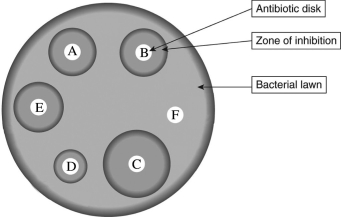Multiple Choice
Scenario
In order to test the susceptibility of bacteria (if the bacteria are susceptible to being killed) to an antibiotic, a common laboratory test called the Bauer-Kirby Disk Diffusion test is used. First, a petri dish (a shallow, circular, transparent dish with a flat lid) is partially filled with nutrient-enriched agar (a gelatinous material) . The nutrients encourage growth of specific bacterial species. The agar is poured as liquid but then typically solidifies to a soft consistency. Once the agar is set, a "lawn" of bacteria is spread such that a thin layer covers the top of the agar. Antibiotics are then applied to the lawn in a small dose, often through small, saturated paper disks. The dish is typically incubated for 24-48 hours and then observed for susceptibility. If the antibiotic is effective, it will kill the bacteria and leave a clear area called the "zone of inhibition" due to inhibited bacterial growth. The area starts at the source of the antibiotic and radiates outward. Scientists measure the diameter of the zone and then compare it to an established "cutoff value" for a zone specific to antibiotic/organism combinations. A large zone of inhibition in comparison to the standard indicates susceptibility while a small or no zone indicates resistance. Consider the following image, and answer the questions that follow: 
-After 1 year of widely prescribed use, reports surface that bacterial infections disappear for up to 2 weeks after taking the FDA-approved antibiotic but then reappear, sometimes worse than the first time. Which explanation might the FDA use to defend their choice of antibiotic to treat the infection?
A) Patients are not taking the antibiotic for the length of time prescribed, and so selection for resistant bacteria that can survive a limited course of the antibiotic is occurring.
B) Stabilizing selection over the year has allowed for the bacteria to remain at a high level in patients' bodies.
C) Patients' bodies are evolving over the year to create environments that are friendly to the growth of the bacteria.
D) Sexual dimorphism allowed for larger bacteria cells to outcompete smaller ones, therefore enabling larger bacteria cells to continue to multiply.
Correct Answer:

Verified
Correct Answer:
Verified
Q4: <b>Scenario</b><br>Over the past 60 years, many amphibian
Q5: The accompanying figure shows what happens in
Q6: Which anatomical features are homologous?<br>A)the forelimb of
Q7: <b>Scenario</b><br>Drs. Peter and Rosemary Grant have been
Q8: Which phenomenon (or lack of)will prevent significant
Q10: Which is NOT a requirement of natural
Q11: Which is a component of the fossil
Q12: Which is a characteristic of a population
Q13: In the Hardy-Weinberg formula, what does p<sup>2</sup>
Q14: In The Origin of Species, Darwin argued